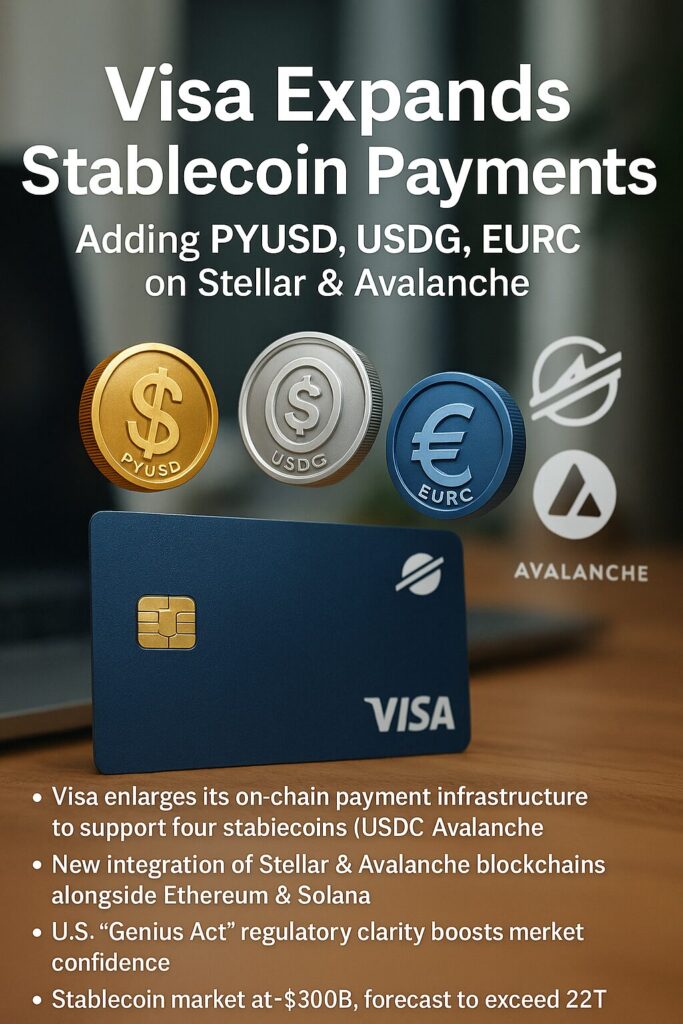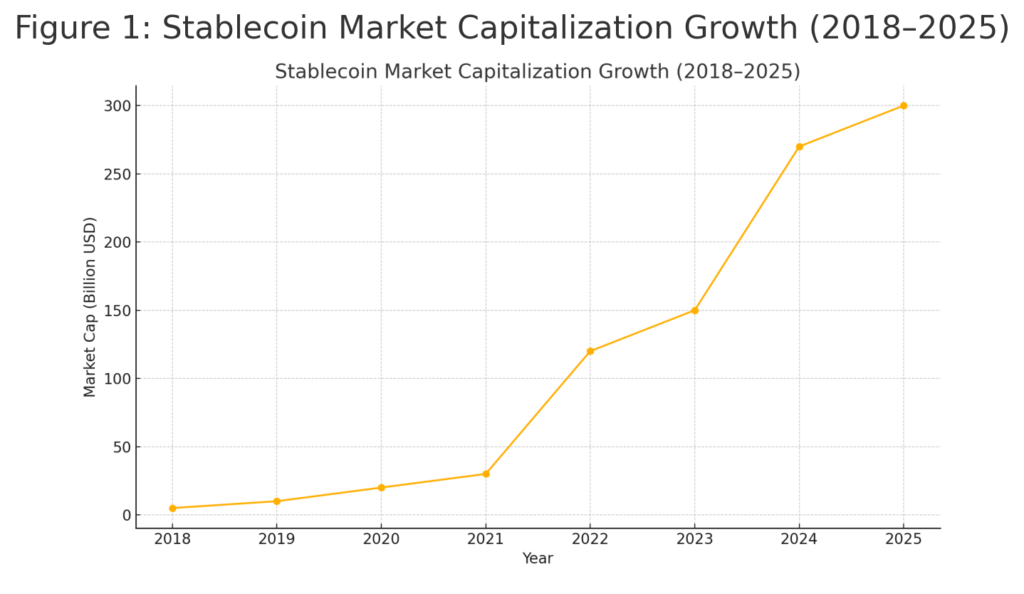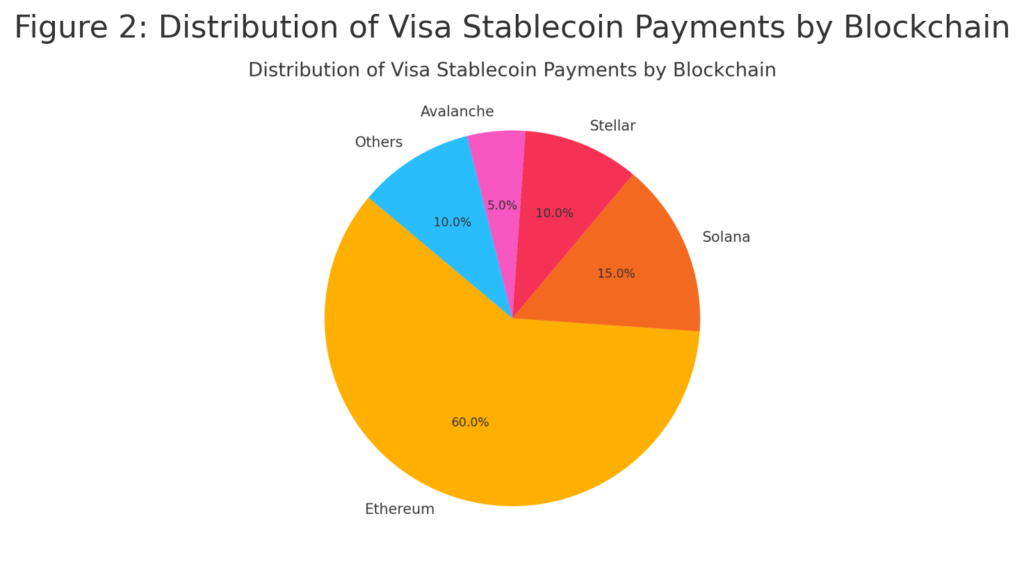
Main Points:
- Visa enlarges its on-chain payment infrastructure to support four stablecoins (USDC, PYUSD, USDG, EURC)
- New integration of two blockchains: Stellar and Avalanche alongside Ethereum and Solana
- U.S. “Genius Act” regulatory clarity boosts market confidence; stablecoin market ~$300 billion, forecast to exceed $2 trillion
- Opportunities for merchants and developers in cross-border payments, programmable money, and DeFi integrations
- Recent trends: rising corporate treasury adoption, central bank stablecoin pilots, NFT marketplace settlements
1. Strategic Expansion of Visa’s On-Chain Payments
Visa announced on July 31, 2025, a significant extension of its stablecoin payment platform, introducing three new stablecoins—PayPal’s PYUSD, Paxos’s USDG (Global Dollar), and Circle’s euro-pegged EURC—and two additional blockchains, Stellar and Avalanche (AVAX). This move increases the network’s supported stablecoins to four (including USDC) and brings total blockchain count to four when paired with existing Ethereum and Solana integrations.
Visa’s expansion aims to provide partner merchants and financial institutions with more flexible, programmable, and cost-effective money movement options. For example, cross-border settlement times can drop from days to seconds, and programmable money rails unlock conditional payments (e.g., automated royalties, subscription billing).
[Insert Figure 1: Stablecoin Market Growth]

2. Deep Dive: Newly Supported Stablecoins
2.1 PYUSD (PayPal USD)
Launched in late 2023, PYUSD represents PayPal’s first native blockchain money. Its integration into Visa’s rails opens PayPal’s 435 million users to on-chain payments via Visa’s merchant network.
2.2 USDG (Global Dollar by Paxos)
USDG is a Paxos-issued dollar token, fully backed and redeemable on demand. Paxos leverages its trust infrastructure to ensure 1:1 reserves and weekly attestation reports, addressing compliance needs.
2.3 EURC (Euro Coin by Circle)
EURC extends on-chain euro payments, a first for Visa partners. As Europe’s digital euro discussions intensify, EURC adoption provides early familiarity with euro-denominated programmable money.
3. Blockchain Integrations: Stellar & Avalanche
Visa’s addition of Stellar and Avalanche expands choices for transaction speed, cost, and ecosystem partnerships:
- Stellar (XLM): Known for sub-five-second settlement and minimal fees (<$0.001), Stellar’s connector to traditional banking rails makes it ideal for micropayments.
- Avalanche (AVAX): Offering sub-second finality and high throughput (4,500 TPS), Avalanche’s smart contract capabilities enable complex DeFi and NFT use cases.
Combined with Ethereum’s developer ecosystem and Solana’s high-speed low-cost execution, merchants can select rails based on use case demands—e.g., micropayments on Stellar, NFT settlements on Solana, DeFi protocols on Avalanche or Ethereum.
[Insert Figure 2: Distribution of Visa Stablecoin Payments by Blockchain]

4. Regulatory Landscape & Market Outlook
In June 2025, the U.S. Congress passed the “Genius Act,” establishing clear federal guidelines for stablecoin issuance and reserve audits. The law mandates 1:1 reserve backing with monthly third-party attestations, reducing systemic risk concerns.
- Current Market Size: Approximately $300 billion total stablecoin market cap (July 2025)
- Forecast: Analysts at ChainSpecies predict a rise above $2 trillion by 2030, driven by DeFi growth, CBDC interoperability, and corporate treasury strategies.
Globally, central banks in Japan, the EU, and the U.K. are piloting CBDCs, often using stablecoin rails as testbeds, which further legitimizes stablecoins and encourages private sector adoption.
5. Practical Implications for Developers & Merchants
5.1 Programmable, Instant Settlement
Developers can leverage Visa’s APIs for atomic payment flows—combining payment finality with on-chain business logic (e.g., automated refund if conditions aren’t met).
5.2 Cross-Border Efficiency
Merchants can now settle euro-and dollar-denominated transactions in minutes, cutting FX costs and hedging exposure by choosing EURC or USDC rails.
5.3 DeFi & NFT Integration
NFT marketplaces seeking settlement guarantees can onboard Avalanche rails for faster confirmations, while DeFi protocols can issue yield-bearing tokens settled via Visa’s stablecoin network.
6. Emerging Trends & Use Cases
- Corporate Treasury Adoption: Treasury departments of Fortune 500 firms are parking idle cash in stablecoin yields of 4–6% APY via DeFi protocols, compared to near-zero bank rates.
- eCommerce & Micro-Tips: Platforms like Twitch and Patreon pilot micropayments using Stellar rails, reducing fees from 30% to under 5%.
- Gaming & Metaverse: In-game economies leverage Avalanche for low-latency microtransactions, enabling real-time NFT purchases.
Conclusion
Visa’s strategic expansion to include PYUSD, USDG, EURC on Stellar and Avalanche solidifies its position as a leading on-chain payment facilitator. By offering diverse rails tailored to speed, cost, and programmability, Visa empowers merchants, developers, and enterprises to innovate in cross-border commerce, DeFi, NFT settlements, and beyond. Regulatory clarity under the Genius Act and ongoing CBDC pilots further underscore stablecoins’ role as the future of digital payments. As the market approaches a potential $2 trillion milestone, businesses should evaluate integrating Visa’s stablecoin rails to stay ahead in the evolving crypto-powered economy.

